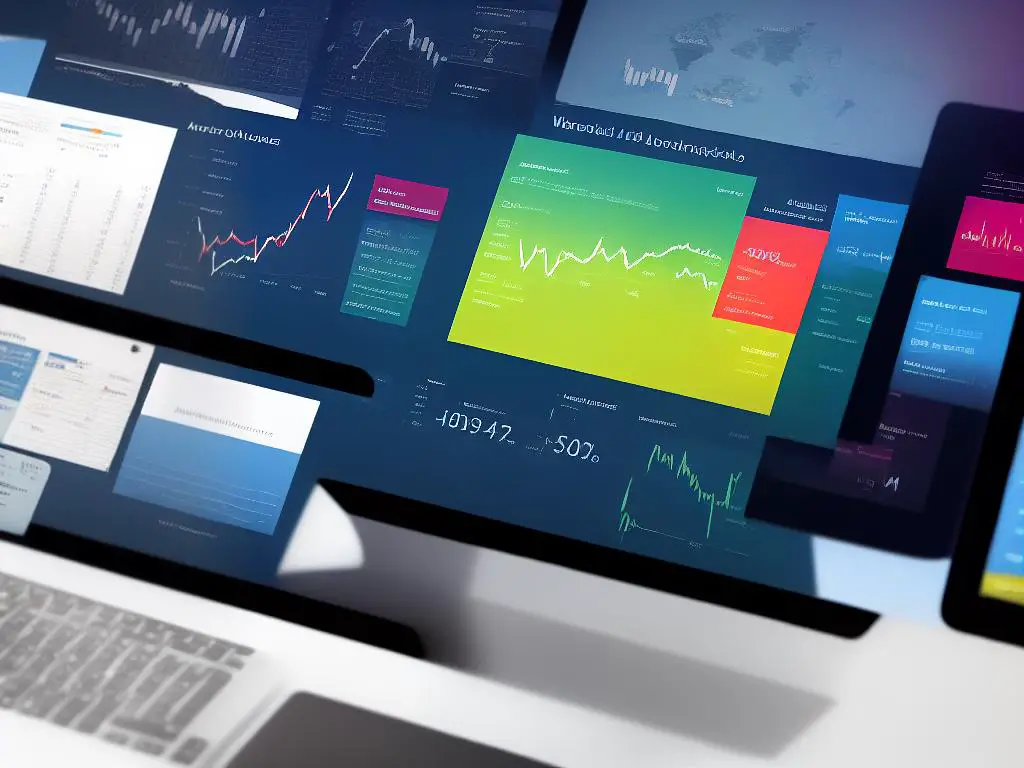In today’s hyper-digital business landscape, understanding user behavior is becoming increasingly critical. Making sense of data patterns and leveraging them for growth is a powerful strategy, and this is where Google Analytics 4 (GA4) comes into play. Replacing its predecessor, Universal Analytics, GA4 brings a host of new features that aim to optimize the precision and utility of web analytics. From setting up GA4 to unraveling its advanced tracking and analysis capabilities, this resource is poised to guide you through the intricacies of GA4, opening up fresh avenues for data-driven decision making in your business. The journey begins with getting familiar with GA4 and its standout features, and leads all the way to mastering its sophisticated tools for advanced analysis.
Understanding GA4: An Overview
Understanding GA4: An Overview
Google Analytics 4 (GA4), launched in October 2020, is the latest generation of Google’s analytics tools. It is designed to provide enterprise-level analytics to businesses large and small. Compared to its predecessor, Universal Analytics (UA), GA4 gives businesses a more comprehensive and accurate understanding of how customers interact with their websites and mobile apps.
Unlike UA that focuses primarily on session-based measurements, GA4 takes an event-driven approach towards data collection. With this approach, websites can track actions taken by visitors, such as clicking a link or watching a video. As a result, businesses get a more complete picture of how users engage with their digital assets.
The difference between GA4 and UA isn’t just about data collection methods. GA4 boasts several advanced analysis techniques and features that offer in-depth insights, catered to today’s data-driven marketing world.
Advanced Analysis in GA4
One of the highlights of GA4 is its in-depth user-centric data. GA4’s Advanced Analysis techniques can help businesses understand their audience at a granular level.
GA4 employs automated machine learning models to help predict future user actions. The predictive metrics allow businesses to focus marketing efforts on high-value customers, thus boosting their marketing efficiency.
Furthermore, GA4 offers a cross-platform tracking feature. Businesses can seamlessly analyze user behaviors across different platforms – mobile, app, web – in a single report. This Advanced Analysis technique allows businesses to understand the customer journey better, pinpoint gaps in the funnel and optimize their strategies accordingly.
GA4 also provides free access to Big Query, Google’s multi-cloud data warehouse, for all properties. This allows businesses to set up custom data pipelines, perform complex BigQuery ML operations, and generate custom insights.
Diving into GA4: Benefits and Strengths
As businesses adapt to the rapidly evolving digital landscape, the shift from Universal Analytics (UA) to Google Analytics 4 (GA4) emerges as a strategic step forward. This transition is largely triggered by the distinct advantages offered by GA4.
GA4’s superior features such as predictive modeling, cross-platform analysis capabilities, and Big Query integration equip businesses with valuable insights into user behavior. This segmentation facilitates the formation of precise marketing strategies, fine-tuned to achieve business objectives and targets.
Furthermore, GA4 is designed for a future without third-party cookies. As these cookies phase out, GA4 steps up with an event-tracking based approach and a dependence on first-party data. This, in turn, makes it a safe and sound choice for businesses to align with the future digital marketing trends.
To sum things up, GA4’s advanced analytic methods supply businesses with a broader range of actionable insights. Its groundbreaking features like predictive analytics, cross-platform analysis, and Big Query integration not only increase marketing effectiveness but also future-proof businesses in a world where data-centric marketing decisions reign supreme.

Setting up GA4: A Step-by-step Guide
Getting to Grips with GA4: A Complete Walkthrough
The process of setting up Google Analytics 4 (GA4) essentially entails the creation of a new property, establishment of data streams, and fine-tuning of the relevant settings. The advanced analysis methods incorporated in GA4 pave the path for securing invaluable insights concerning website visitors and their consequent behavior.
Creating a New Property
Establishing a new property is the first step in setting up GA4. A property is where user interactions and data collections occur, making it crucial in GA4 analytics. To create a new property:
- Sign in to your Google Analytics account.
- Click ‘Admin,’ usually represented by a gear icon.
- Within the ‘Account’ column, choose the relevant account for the property.
- In the ‘Property’ column, click ‘Create Property.’
- Fill in property details like the website URL and industry category. Click ‘Show Advanced Options’ to enable GA4 setup.
Remember to input accurate information for precision in data analysis.
Configuring Data Streams
After creating a GA4 property, data stream configuration follows. This process involves choosing where you want the data collected from – be it a website, an iOS app, or an Android app. Data streams broaden the dimensions of your data, enabling you to understand user interactions better.
- Navigate to the ‘Admin’ section.
- In the ‘Property’ column, select the property you wish to add the data stream to.
- Choose ‘Data Streams’ and click ‘Add stream.’
- Depending on your source, choose ‘Web,’ ‘iOS,’ or ‘Android.’
The data stream configuration automatically updates the measurement ID, which you need to implement on your website or mobile application.
Configuring Necessary Settings
Finalizing the GA4 setup requires configuring vital settings. These include demographic details, data retention, and automated tracking amongst others.
- For demographic details, go to ‘Admin’ > ‘Property Settings’ > ‘Audience Definitions.’ Click ‘Audiences,’ then ‘+NEW’ to create a new audience based on specific criteria.
- For data retention settings, navigate to ‘Admin’ > ‘Property Settings’ > ‘Data Settings’ > ‘Data Retention.’ Choose your preferred retention period for event data.
- To set automatic tracking, select ‘Admin’ > ‘Property Settings’ > ‘Data Streams’ > ‘Your Website.’ Enable the automatic tracking options applicable to your site.
Taking the time to configure these settings will provide a more robust framework for the data GA4 will be collecting, analyzing, and reporting.
Introduction
Leveraging GA4’s advanced analysis techniques opens up vast opportunities to understand your audience better. The tool provides, through a meticulous approach in setting up a new property, data streams, and tailoring the necessary configurations, a comprehensive view of audience interaction and behavior. Accuracy in configuration guarantees precise data tracking essential in formulating well-informed business strategies. However, it’s vital to remember that each organization is distinct; thus, settings should be tailor-made to align with specific needs and objectives.

Event Tracking in GA4
Decoding GA4 Event Tracking
Google Analytics 4 (GA4) is renowned as a comprehensive analytic tool utilized by marketers to understand their audience and their interactions with various digital media. Its standout feature is event tracking, which sheds light on user actions and engagements across a website or an app.
Events can range from page views, button clicks, form submissions, e-commerce transactions to video plays, thereby enabling every minor to major user interaction with your platform to be tracked.
Customizing Event Tracking
GA4’s event tracking offers remarkable flexibility and customization. It allows you to establish custom events that meet your specific needs or business objectives, providing insights that resonate with your unique requirements.
To create a custom event, you must initially transmit an event to Google Analytics from your website or app either by modifying your code or using a Google Tag Manager. Whenever a trackable action is performed, an event hit is sent to Google Analytics, which includes the event name and any associated parameters.
Introducing Automatic Event Tracking
GA4 also provides the convenience of automatic event tracking, which minimizes the need for coding. Automatic events are those that GA4 tracks automatically when certain conditions are fulfilled, without any requirement for specific configuration from your side.
Key automatic events such as first visit, user engagement, scrolls, and clicks are tracked by default as soon as GA4 is implemented on your platforms.
Understanding Out-of-the-Box GA4 Events
GA4 also comes with out-of-the-box events, in addition to custom and automatic events, to support reporting and analysis. These predefined events, which GA4 recognizes and offers special reporting for, include purchase events, lead generation, view item, begin checkout, among others.
Role of Event Tracking in GA4 Advanced Analysis Techniques
Each logged event creates raw data useful for advanced analysis techniques. The collected information provides insight into user behavior patterns, user journey mapping, and conversion pathways, among others.
Furthermore, GA4’s Analysis Hub encompasses advanced techniques such as exploration, path analysis, segment overlap, and funnel analysis. If leveraged with detailed information from event tracking, these techniques can offer a holistic understanding of user interactions and engagement with your platform.
For instance, funnel analysis can help visualize user’s path from first interaction to final conversion. Using the data from event tracking, it’s possible to create specific funnels based on the events and evaluate user engagement and the points of drop-off.
Another feature, path analysis, can map out the user journey using data from event tracking, helping identify popular paths and areas requiring improvement.
To summarize, the advanced event tracking capability of GA4, along with its advanced analytics techniques, provides a formidable toolkit for analyzing and enhancing user experiences. Understanding and effectively utilizing these features can yield impactful insights that fuel business growth and efficiency.
![]()
GA4 Reporting: Insights for Business
Advancing Your Game with GA4 Reporting: An Exploration of Advanced Analysis Techniques and Valuable Insights
Being the most updated version of Google’s widely-used web analytics tool, Google Analytics 4 (GA4) comes packed with new capabilities enhancing its reporting and analysis functions. Leveraging GA4 fully, therefore, can provide you not just the numbers but insightful interpretations and practical implications to boost your business.
Understanding the Data in GA4 Reports
To begin with, GA4 provides reports with an array of metrics, including engagement data, demographic information, sources of traffic, conversion rates, and more. Understanding these metrics is crucial to extract meaningful insights from your data. For instance, high levels of engagement might suggest that your website is effectively capturing user interest, while low conversion rates might indicate the need to improve your call to action prompts.
Generating Useful GA4 Reports
Generating useful reports in GA4 involves defining your objectives and understanding your relevant metrics. For instance, if your objective is to increase website traffic, then you need to track metrics like the number of users, sessions, page views, and referral sources, among others.
Firstly, you need to navigate to the ‘Reports’ section on your GA4 dashboard and click on the ‘Create Custom Report’ button. Here, you can select and tweak the variables you’re interested in analysing. GA4 allows for customization in selecting the dimensions (like demographics, channel, landing page, and more) and metrics (like users, sessions, bounce rate, etc.) you want to analyse.
Secondly, It’s important to segment your data to gain more granular insights. GA4 lets you slice and dice your data using various parameters like demographics, user behavior, and source/medium. For instance, you might want to segment your data to understand how user behavior varies between organic and paid traffic.
Finally, leverage GA4’s machine learning capabilities to forecast future trends based on historical data. This can help you anticipate changes and adapt your strategies accordingly.
Deciphering Actionable Insights for Business Growth
The insights provided by GA4 reports should drive your decision-making and strategy development. For example, if you notice a high bounce rate on a particular landing page, this might indicate issues with that page, prompting you to investigate and resolve them.
Furthermore, you can track the customer journey in GA4, which can help you understand where potential customers might be dropping off. This can guide optimizations aimed at improving user experience and conversion rates.
In addition, analyzing demographic data can reveal the characteristics of your most valuable customers, enabling you to better target your marketing efforts.
Finally, tracking the success of your marketing campaigns in GA4 can provide insight into what’s working and what’s not, allowing you to optimize your marketing spend.
The Power of GA4 in Business Strategy
Google Analytics 4 (GA4) presents a powerful means of growth for businesses by offering advanced analysis capabilities. The availability of custom reporting, data segmentation, and predictive insights makes it robust tool for data-driven decision-making, allowing for effective strategizing.

GA4 Advanced Analysis: Techniques and Tools
Delving Deeper into GA4: Path and Cohort Analysis
Digging deeper into the features of GA4, it can be seen how it has considerably evolved the landscape of digital analytics by introducing sophisticated and high-functioning tools. Businesses can get a comprehensive understanding of their website’s user behavior, made possible largely due to GA4’s significant additions: Path Analysis and Cohort Analysis.
GA4 Path Analysis: A User Journey
Path Analysis, a dimension of GA4’s advanced suite, provides insight into the steps users take on your website, starting from their entry up to their conversion or exit. This tool helps businesses understand the navigation patterns of their users and the sequence of events leading to conversions.
For example, a web user may land on a blog post, explore the “About Us” page, browse through the products, then finally make a purchase. Each of these steps is a part of the user’s ‘path’, as tracked by GA4.
To effectively utilize Path Analysis, it is recommended to:
- Specify a Limit: Limiting the length of the path can help to focus on key user actions and interactions.
- Include All Events: Ensure that all potential interactions or activities that a user could undertake on the site are included in the tracking.
- Constant Analysis: Regularly assess the user paths to identify changes or trends in interaction and navigation patterns.
Moreover, businesses should also examine the common paths leading to drop-offs to address potential user-experience issues.
Cohort Analysis: A Segment-Based Approach
Cohort Analysis, another advanced feature of GA4, allows businesses to group users sharing common characteristics over a specific period.
Businesses can track and compare how different cohorts behave over similar spaces of time. For instance, you may categorize users who arrived at your website via a specific marketing campaign into a single cohort. Then, you can track this group’s behavior over time, especially their engagement with the site and any subsequent purchases they make.
To make the most out of GA4’s Cohort Analysis, businesses are advised to:
- Segment Cohorts Smartly: Segmentation should be done logically based on attributes relevant to business objectives or strategies. This might include the source of visitor traffic, geographical location, user demographics, etc.
- Follow Through: After cohort creation, the subsequent behavior of these users on the website should be tracked and analyzed, giving insights about the effectiveness of a marketing campaign or any shifts in user behavior.
- Use Cohort Analysis for Predictions: The behavior of recent cohorts can be used to make predictive analyses on user behavior trends, helping businesses strategize better.
In Conclusion: Leveraging GA4’s Advanced Tools
GA4’s advanced analysis tools, namely Path Analysis and Cohort Analysis, provide businesses with an unprecedented level of insight into user behavior on their websites. This allows for more informed decision-making when planning marketing strategies, improving user satisfaction, and ultimately driving business growth.
However, regular, diligent monitoring is necessary to ensure these tools’ fullest potential is tapped; only consistent tracking can help identify and adapt to dynamic user behavior trends.

After exploring GA4 from its initial setup to advanced analysis tools, one can appreciate the value it brings into the realm of data analytics. Not only does it advance our understanding of user behavior, it propels it into new dimensions, offering deeper, more actionable insights that can drive business growth. Whether it’s event tracking that helps identify user interactions or advanced reporting that turns raw data into understandable and usable information, GA4 emerges as an indispensable tool. As you continue to untangle and utilize the functionalities of GA4, you’re taking meaningful strides towards harnessing the true power of data in your business strategies.

